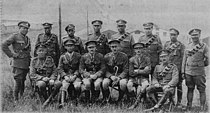Royal Garrison Artillery
| Royal Garrison Artillery | |
|---|---|
|
Officers and senior enlisted men of the Bermuda Contingent of the Royal Garrison Artillery's draft to the Western Front, during the Great War. Part of a contingent from the part-time reserve, the Bermuda Militia Artillery
|
|
| Active | 1899–1924 |
| Country |
|
| Branch |
|
| Motto(s) |
Quo Fas Et Gloria Ducunt (Wherever right and glory leads) Ubique (Everywhere) |
The Royal Garrison Artillery (RGA) was an arm of the British Army's Royal Artillery that was originally tasked with manning the guns of the British Empire's forts and fortresses, including coastal artillery batteries, the heavy gun batteries attached to each infantry division, and the guns of the siege artillery.
The Royal Garrison Artillery came into existence as a separate entity when existing coastal defence, mountain, siege and heavy batteries of the Royal Artillery were amalgamated into a new sub-branch. A royal warrant provided that from 1 June 1899:
"... the mounted and dismounted branches of the Royal Regiment of Artillery shall be separated into two corps... to be named respectively (a) the Royal Horse Artillery and the Royal Field Artillery: (b) the Royal Garrison Artillery."
The Royal Regiment of Artillery, thenceforth, was divided into four branches. Other than mounted or unmounted dress, the obvious distinction in uniform was by the shoulder title badges: RGA; RFA; RHA; and RA (for the branch tasked with managing ammunition dumps and supply to units in the field).
The RGA retained the badge and dress uniform (dark blue with scarlet facings) of the Royal Regiment of Artillery, but personnel were normally clothed and equipped as dismounted men. After 1920 all RGA personnel were classified as mounted men, whether serving in horse-drawn, mountain or tractor-drawn batteries,
From 1914 when the army possessed very little heavy artillery, the RGA grew into a very large component of the British forces on the battlefield, being armed with heavy, large-calibre guns and howitzers that were positioned some way behind the front line and had immense destructive power. The corps name was discontinued in 1924, when the RGA was re-amalgamated into the Royal Artillery.
Prior to the First World War artillery would manoeuvre on the battlefield beside the infantry and cavalry. The field artillery would form part of a battle line alongside the infantry and, on occasion, the horse artillery would charge alongside the cavalry with guns, limbers and caissons and all.
Fixed artillery (that which is not meant to move, other than for the purpose of aiming) was placed in forts and batteries in locations where they might protect potential targets (ports, cities, etc.) from attack, or from where they might prevent the advance of an enemy. This included forts and batteries intended to protect against military forces on the land, and against naval forces on the sea. Coastal artillery relied primarily on high velocity guns, capable of striking out at ships at a great distance, and penetrating their armour. Inland defensive batteries might have armament better suited for use against personnel. Mobile (field) artillery pieces were sometimes used that could be quickly re-deployed as required between fortifications that were not permanently manned or armed. Fixed batteries were operated in the early 20th Century by the RGA, including its Militia Artillery and Volunteer Force reservists (often with support from other units, such as engineers operating searchlights for night-time firing).
...
Wikipedia

